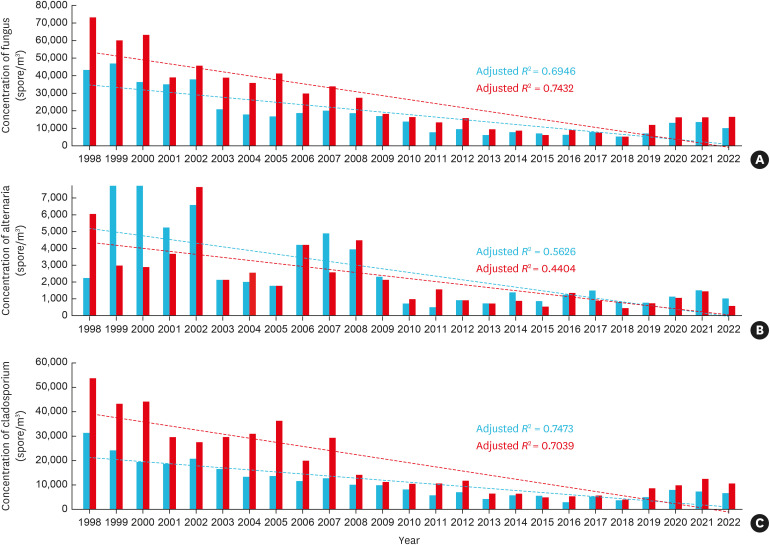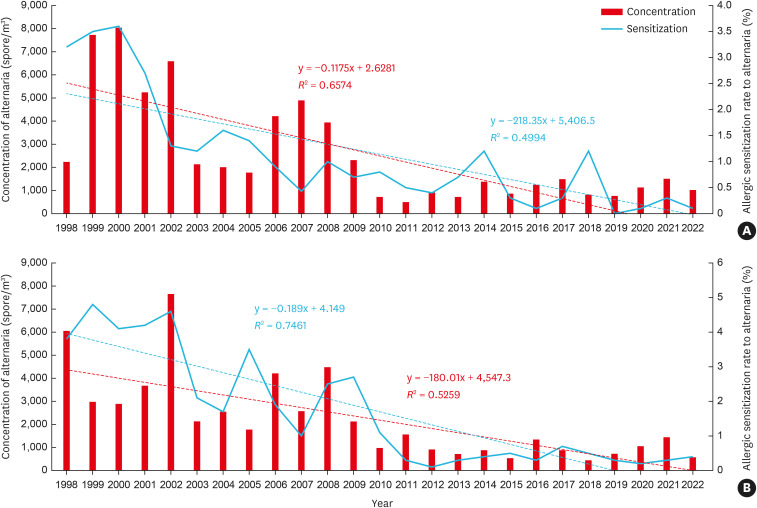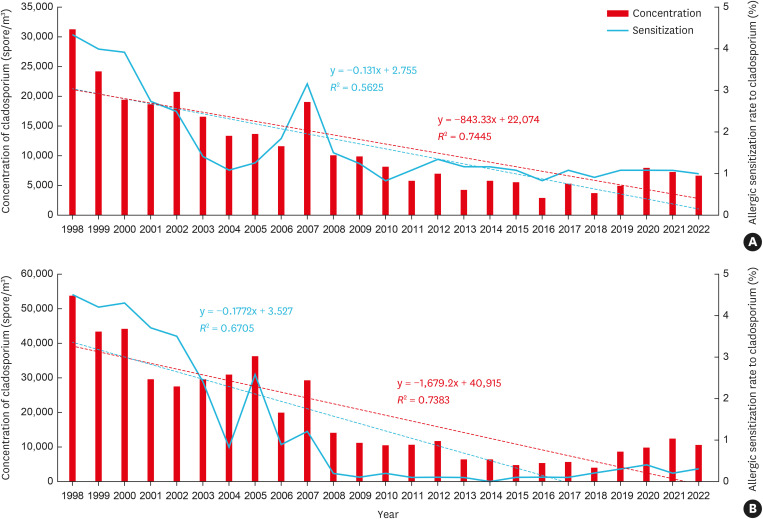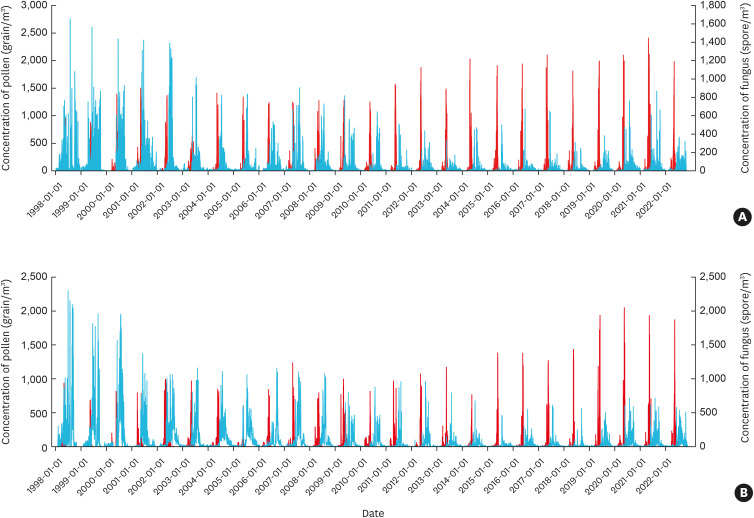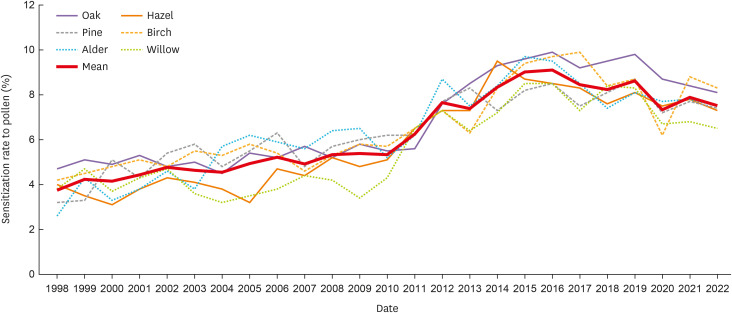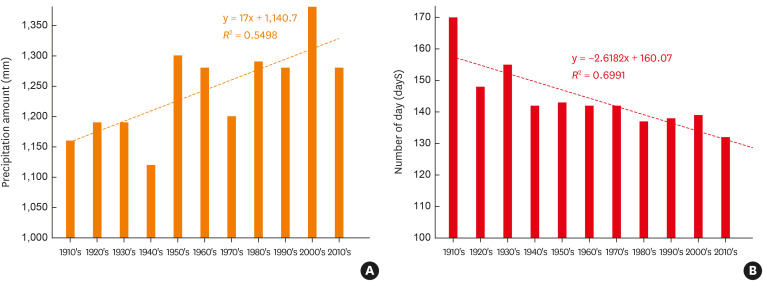Abstract
Purpose
Atmospheric fungi are associated with respiratory allergies in humans, and some fungal spores can cause allergic diseases. Environmental and biological factors influence the concentrations of atmospheric spores. In this study, we evaluated the climate change-induced annual variations in fungal spore concentrations and allergic sensitization rates in the Seoul Metropolitan Area over a period of 25 years.
Methods
Fungal spores and pollen were obtained from Hanyang University Seoul and Guri Hospitals; they were identified and counted for 25 years (1998-2022). The study participants included patients who underwent tests for allergic diseases in both hospitals. Their allergenic sensitization rates were determined via allergic skin prick and serum tests, after which their sensitization rates to allergenic fungi and pollens were calculated. The daily climatic variables were obtained from the Korea Meteorological Administration.
Results
The total annual atmospheric fungal concentrations decreased in both areas during the period. Simultaneously, we recruited 21,394 patients with allergies (asthma, 1,550; allergic rhinitis, 5,983; and atopic dermatitis, 5,422) from Seoul and Guri Hospitals for allergenic fungal sensitization evaluations over the period. The allergenic fungal sensitization rates decreased annually in both areas over that time `+(Alternaria [3.5%] and Cladosporium [4.4%] in 1998; Alternaria [0.2%] and Cladosporium [0.2%] in 2022). In contrast, the annual pollen concentrations increased with the sensitization rates to pollen in children.
Conclusions
The atmospheric fungal concentrations decreased annually, with allergic sensitization rate decreasing over the period of 25 years. Allergenic fungal sporulation could decrease with climate changes, such as desertification and drought. Extended monitoring periods and further large-scale studies are required to confirm the causality and to evaluate the impact of climate change.
Keywords: Fungal spores, mold, pollen, pollen allergy, climate change, allergic disease, skin prick test, Alternaria, Cladosporium
INTRODUCTION
Atmospheric fungal spores are linked to human respiratory allergies.1,2 Their concentrations are influenced by a wide range of environmental, meteorological, and biological factors as well as various interspecies interactions. An increase in concentrations of atmospheric fungal spores is associated with severity of allergic rhinitis2,3 and asthma-related hospital visits and admissions.4,5 There are an estimated 1 to 1.5 million species of fungi in the world, but only 80,000 have been identified so far.6 Of these, 112 are known to be allergens. Among them, Alternaria and Cladosporium are most commonly associated with allergy development.6,7 Alternaria alternata and Cladosporium herbarum can cause type-1 allergic reactions and induce allergic asthma and rhinitis.8,9,10 The risk of asthma-related death is more than double with high incidence of fungal spores, and Alternaria exposure is a known risk factor for asthma in children and young adults.11 Grain crops and their harvesting processes are associated with increases in atmospheric concentrations of Alternaria and Cladosporium species, which disperse over a wide area.12,13,14,15 The threshold number of spores that can elicit allergic symptoms in sensitized patients is unknown and varies across species.3,4 Only a few studies have assessed the long-term trends in concentrations of air spores, and they obtained inconsistent results.3 Furthermore, the effects of fungal load and climate change have not yet been completely evaluated in the field of allergic disease.
A growing number of people are developing pollen-related allergic diseases as a result of climate, lifestyle, and environmental changes. According to recent studies, 15%–25% of the population has currently developed pollen-related allergic disease.16,17,18 Climate change is one of the factors that can change the concentration and sensitization rate of pollen.19
We evaluated the annual change in fungal concentrations and the allergic sensitization rate to Alternaria and Cladosporium species over the past 25 years. We aimed to determine the effects of environmental change in the Korean metropolitan area over the period on fungal concentrations and sensitization rates.
We further examined changes in pollen concentrations and sensitization rates over the period to evaluate the effects of environmental change in the metropolitan area on pollen and outdoor fungus concentrations and sensitization rates
MATERIALS AND METHODS
Allergic outdoor fungus and pollen identification and counting
Fungal spores and pollens were collected from Hanyang University Seoul and Guri Hospitals between January 1, 1998, and December 31, 2022. The fungal spore and pollen distributions were measured daily after installing a 7-day volumetric spore trap (Burkard Manufacturing Co., Hertfordshire, UK) at a height of 1.5 m from the surface of the hospital roof. We collected outdoor fungi and pollen-containing drums weekly and examined by 2 specialists. Glycerin-adhesive vinyl was stained with Calberla’s fuchsin staining solution (glycerin, 10 mL; 95% alcohol, 20 mL; distilled water, 30 mL; and basic fuchsin, 0.2 mL) and identified under an optical microscope (OLYMPUS/BX43; Olympus Life Science, Tokyo, Japan) at 400× magnification. The numbers of fungus spores and pollen grains per m3 were also calculated. The allergens were categorized according to size, shape, and surface pattern. Measurement tools and methods have not changed in the period of 25 years.
Patient selection and determination of allergic sensitization rates to outdoor fungi and pollens
Participants were patients with allergy symptoms who underwent allergy tests, such as allergic skin prick and serum tests, at one of the 2 hospitals (Hanyang University Seoul and Guri Hospitals). Their allergenic sensitization rates were calculated based according to results of allergic skin prick and serum tests, and their sensitization rates to fungi and pollens were calculated using the number of patients that were sensitized to the tested fungi and pollens as a percentage of the overall allergy-tested population. We excluded patients who did not undergo allergy tests or whose test results were missing from the medical records. Data regarding sensitization rates to allergenic fungi were selected according to results obtained from the skin prick and quantitative serum tests for allergen-specific immunoglobin E (IgE). We maintained standard allergen panels in each institute throughout the study.
Sensitization to allergenic fungi and pollens was defined as follows. A positive reaction in the multiple antigen simultaneous test (MAST) was defined as an Allergen-specific serum level of IgE greater than or equal to class 3. A raised wheal was measured in the skin prick test and defined as positive when the wheal was equal to or greater than the histamine control (≥ 3 mm).20,21 The number of patients with ImmunoCAP test alone was very small and difficult to collect the data, so it was excluded.
Meteorological data
The daily records of climate variables, including precipitation and rainfall, were obtained from the Korea Meteorological Administration and used to represent daily weather conditions near the fungus- and pollen-monitoring sites. The nearest weather station (Seongsu-dong, Seongdong-gu, Seoul and Topyeong-dong, Guri, Gyeonggi-do Province, Korea) to each fungaus- and pollen-sampling site was selected to provide meteorological data. The daily and weekly average humidity and precipitation data were collected from January 1, 1998, to December 31, 2022, using data published by the Meteorological Agency (www.weather.go.kr).
Climate is a generalized state of the atmosphere that recurs from year to year in a particular place.22 Because climate constantly fluctuates, the average value of the last 30 years is used as a baseline for the current climate. As climate has been changing in recent years, a decadal average has been calculated separately as an indicator of climate change.22 Therefore, we checked the climate of the past 100 years by decade to see the changes in precipitation and precipitation days among the changes in climate.
Statistical analysis
Longitudinal fungal data were analyzed to determine the potential relationship between sensitization rates during the fungus collection period. We used R (version 4.0.2; R foundation, Vienna, Austria, https://www.r-project.org) for statistical analysis. The changes in the rate of sensitization to allergenic fungi were assessed via linear regression and time-series analyses. We estimated a standardized regression coefficient using the least-squares method to minimize the sum of the squared residuals; we determined independent variables that significantly influenced dependent variables. A large sample size increases the R-value, so we used an adjusted R2 to avoid this.23
Ethics statement
This study was approved by the Institutional Review Board of Hanyang University Guri Hospital (IRB No. HYI-10-45). The requirement for informed consent was waived because of the retrospective nature of our study.
RESULTS
Patient characteristics
In this study, 21,394 patients with allergic diseases were recruited from the 2 hospitals. The patients were afflicted by the following conditions (Table): asthma (n = 1,550), allergic rhinitis (n = 5,983), atopic dermatitis (n = 5,422), multi-allergic disease (more than two allergic diseases n = 471), and other allergic diseases (urticaria, anaphylactic reactions n = 5,050).
Table. Characteristics of allergic diseases of the study subjects.
| Year | Seoul | Guri | ||||||||||
|---|---|---|---|---|---|---|---|---|---|---|---|---|
| Total | Asthma | Allergic rhinitis | Atopic dermatitis | Multi-allergic diseases | Other allergic diseases | Total | Asthma | Allergic rhinitis | Atopic dermatitis | Multi-allergic diseases | Other allergic diseases | |
| 1998 | 120 | 2 | 67 | 35 | 5 | 11 | 359 | 36 | 151 | 118 | 1 | 53 |
| 1999 | 132 | 10 | 84 | 16 | 6 | 17 | 602 | 75 | 208 | 221 | 11 | 87 |
| 2000 | 139 | 12 | 77 | 28 | 4 | 17 | 657 | 47 | 284 | 238 | 6 | 82 |
| 2001 | 264 | 21 | 91 | 110 | 17 | 25 | 645 | 28 | 281 | 208 | 18 | 110 |
| 2002 | 162 | 15 | 117 | 11 | 7 | 12 | 156 | 25 | 70 | 36 | 4 | 21 |
| 2003 | 171 | 6 | 135 | 20 | 1 | 9 | 363 | 22 | 165 | 126 | 4 | 46 |
| 2004 | 120 | 0 | 87 | 22 | 0 | 11 | 359 | 36 | 151 | 118 | 1 | 53 |
| 2005 | 132 | 1 | 93 | 21 | 0 | 17 | 602 | 75 | 208 | 221 | 11 | 87 |
| 2006 | 139 | 1 | 89 | 32 | 0 | 17 | 657 | 47 | 284 | 238 | 6 | 82 |
| 2007 | 264 | 0 | 89 | 148 | 0 | 27 | 645 | 28 | 281 | 208 | 18 | 110 |
| 2008 | 256 | 0 | 65 | 162 | 1 | 28 | 561 | 34 | 216 | 180 | 15 | 116 |
| 2009 | 250 | 1 | 89 | 133 | 1 | 26 | 408 | 4 | 186 | 122 | 2 | 94 |
| 2010 | 211 | 2 | 56 | 120 | 0 | 33 | 678 | 53 | 199 | 225 | 15 | 186 |
| 2011 | 199 | 0 | 78 | 90 | 1 | 30 | 665 | 48 | 256 | 191 | 14 | 156 |
| 2012 | 257 | 1 | 91 | 99 | 1 | 65 | 670 | 43 | 176 | 212 | 18 | 221 |
| 2013 | 268 | 6 | 96 | 97 | 2 | 67 | 630 | 50 | 128 | 167 | 11 | 274 |
| 2014 | 257 | 7 | 101 | 93 | 2 | 54 | 694 | 58 | 185 | 156 | 19 | 276 |
| 2015 | 336 | 8 | 109 | 116 | 4 | 99 | 725 | 90 | 212 | 167 | 20 | 236 |
| 2016 | 334 | 14 | 129 | 100 | 4 | 87 | 870 | 101 | 252 | 200 | 30 | 287 |
| 2017 | 376 | 16 | 152 | 101 | 20 | 87 | 777 | 92 | 180 | 156 | 21 | 328 |
| 2018 | 405 | 26 | 120 | 88 | 25 | 146 | 920 | 89 | 185 | 212 | 32 | 402 |
| 2019 | 492 | 34 | 148 | 139 | 23 | 148 | 861 | 156 | 167 | 187 | 40 | 311 |
| 2020 | 297 | 17 | 51 | 106 | 14 | 109 | 689 | 103 | 163 | 175 | 21 | 227 |
| 2021 | 418 | 77 | 103 | 90 | 14 | 134 | 707 | 83 | 163 | 220 | 32 | 209 |
| 2022 | 191 | 38 | 52 | 49 | 7 | 45 | 304 | 43 | 106 | 68 | 10 | 77 |
| Total | 6,190 | 270 | 2,050 | 1,837 | 127 | 1,251 | 15,204 | 1,280 | 3,933 | 3,585 | 344 | 3,799 |
Annual variation in atmospheric fungal concentrations over the past 25 years
Various outdoor fungi such as Alternaria, Cladosporium, Leptospheria, Penicillium, Basidiospores, and Candida were collected using the spore trap. We defined Alternaria and Cladosporium as allergenic outdoor fungi among atmospheric fungi and measured their concentrations. Total annual allergenic outdoor fungal concentrations decreased over the past 25 years in both study areas. The total fungal concentrations in Seoul were 43,273 and 10,124 spores/m3 in 1998 and 2022, respectively (adjusted R2 = 0.69), whereas the total fungal concentrations in Guri were 73,199 and 16,514 spores/m3 (adjusted R2 = 0.74), with marked decreases in each species (Fig. 1A). Concentrations of Alternaria were 2,237 and 1,022 spores/m3 in Seoul in 1998 and 2022, respectively (adjusted R2 = 0.56), whereas concentrations in Guri were 6,053 and 577 spores/m3 (adjusted R2 = 0.4404) (Fig. 1B). Cladosporium concentrations in Seoul were 31,324 and 6,661 spores/m3 in 1998 and 2022, respectively (adjusted R2 = 0.7473), and they were 53,735 and 10,609 spores/m3 in Guri (adjusted R2 = 0.7039, Fig. 1C).
Fig. 1. Changes in the annual concentrations of fungal spores in Seoul (blue) and Guri (red), Korea over a period of 25 years. The total annual atmospheric fungal concentrations decreased in both areas. (A) The total fungal concentrations in Seoul were 43,273 and 10,124 spore/m3 in 1998 and 2022, respectively, whereas the total fungal concentrations in Guri were 73,199 and 16,514 spore/m3 in 1998 and 2022, respectively, marked decreases in total outdoor fungi concentration. (B) The concentrations of Alternaria were 2,237 and 1,022 spore/m3 in Seoul in 1998 and 2022, respectively, whereas the concentrations in Guri were 6,053 and 577 spore/m3, respectively. (C) Cladosporium concentrations in Seoul were 31,324 and 6,661 spore/m3 in 1998 and 2022, respectively, whereas they were 53,735 and 10,609 spore/m3 in Guri, respectively.
Annual change in the sensitization rates to allergenic outdoor fungi
The sensitization rates to Alternaria and Cladosporium decreased annually in both areas over the study period. In Seoul, the allergic sensitization rates to Alternaria were 3.5% and 0.2% in 1998 and 2022, respectively (adjusted R2 = 0.4994, Fig. 2A). In Guri, these rates were 3.8% and 0.3%, respectively (adjusted R2 = 0.7461, Fig. 2B). In Seoul, the allergic sensitization rates to Cladosporium were 4.4% and 0.2% in 1998 and 2022, respectively (adjusted R2 = 0.5625, Fig. 3A), and in Guri they were 4.5% and 0.3% in 1998 and 2022, respectively (adjusted R2 = 0.6705, Fig. 3B).
Fig. 2. Correlations between atmospheric concentrations (red bar) and allergic sensitization rates (blue line) to Alternaria in Seoul (A) and Guri (B). In Seoul, allergic sensitization rates to Alternaria were 3.5% and 0.2% in 1998 and 2022, respectively; in Guri, the rates were 3.8% and 0.3%, respectively.
Fig. 3. Correlations between atmospheric concentrations (red bar) and allergic sensitization rates (blue line) to Cladosporium in Seoul (A) and Guri (B). In Seoul, allergic sensitization rates to Cladosporium were 4.4% and 0.2% in 1998 and 2022, respectively; in Guri, they were 4.5% and 0.3%, respectively.
Comparisons of concentrations of atmospheric outdoor fungi and pollens
Compared to allergenic outdoor fungal concentration, pollen concentration increased annually during the same period. Total pollen concentrations in Seoul were 10,536 and 17,682 grains/m3 in 1998 and 2022, respectively (adjusted R2 = 0.59), whereas total fungal concentrations in Guri were 7,046 and 16,382 grains/m3, respectively (adjusted R2 = 0.64, Fig. 4). The sensitization rate to allergenic pollens, such as oak, birch, alder, and hazel, increased with increasing concentrations of allergenic pollens in the Seoul metropolitan area (Fig. 5).
Fig. 4. Comparison of the annual concentrations of pollen grains (red) and fungal spores (blue) in Seoul (A) and Guri (B) for the past 25 years. In contrast to atmospheric fungal concentration, pollen concentration increased annually during the same period.
Fig. 5. Changes in the sensitization rates to pollens in the Seoul metropolitan area during the study period. The sensitization rates to allergic pollens, such as oak, birch, alder, and hazel, increased with increasing concentrations of allergenic pollens in the Seoul metropolitan area.
Long-term precipitation trend in Korea
According to precipitation change data for the past 100 years, annual precipitation increased by 135.4 mm, and the number of precipitation days decreased by 21.2 days. Annual precipitation over the last 100 years increased by +17.71 mm/decade (Fig. 6).24
Fig. 6. Longitudinal precipitation trends per decade in Korea over the last 100 years. (A) Precipitation; (B) Number of precipitation days. The annual precipitation increased by 135.4 mm, while the number of precipitation days decreased by 21.2 days. The annual precipitation over the last 100 years increased by +17.71 mm per decade.
DISCUSSION
Atmospheric concentrations of A. alternata and C. herbarum decreased at the 2 sites in the Seoul metropolitan area over the past 25 years, and the number of allergic patients who were sensitized to A. alternata and C. herbarum decreased annually. In Seoul, allergic sensitization rates to A. alternata were 3.5% and 0.2% in 1998 and 2022, respectively; in Guri, they were 3.8% and 0.3%, respectively. In Seoul, allergic sensitization rates to C. herbarum were 4.4% and 0.2% in 1998 and 2022, respectively; in Guri, they were 4.5% and 0.3%, respectively. The exact sensitization rate of the general population to fungi is unknown, although it is estimated to be in the range of 2%-10%.25 Our sensitization rates were lower than those reported in other recent studies, which may be because we excluded patients who did not undergo allergy testing or whose test results were missing from the medical records. This may also be why our results differed from the actual number of allergic patients. Additionally, the prevalence of sensitization among atopic individuals varies depending on numerous factors such as air pollutant.25,26 Our study was conducted in the urban areas of Korea with few green spaces and many buildings; thus, the sensitization rate may differ from studies in other areas.
Fungi can sustainably break down cellulose to produce glucose as long as moisture is available.27 Therefore, humidity is a crucial factor for sporulation. Korea has recorded a long-term trend of higher precipitation over the past years, with annual precipitation increasing by +17.71 mm per decade. However, the number of precipitation days has decreased correspondingly by 21.2 days over the past 25 years.24 The amount and intensity of precipitation during the summer and autumn increased significantly, and the number of days with precipitation decreased throughout the seasons. Even though there was an increase in precipitation, it was concentrated over a short period of time. These changes in precipitation trends may have augmented dry season duration, which reduced the sporulation period for fungi requiring moisture. Thus, the number of fungal spores and the sensitization rate may have decreased as the exposure to spores decreased.
The opposite result was observed with increases in both pollen concentration and sensitization rate over the past 25 years. Climate change will induce an earlier starting point and later ending point for pollinosis, prolonging the pollen season. Climate change may also escalate pollen distribution, increase pollen loads, and alter pollen allergenicity.19,28 Therefore, as the concentration of pollens increases annually, pollen sensitization will increase as well. However, continuous large-scale studies are required to confirm causality and to evaluate the impact of climate change on the concentrations of airborne fungal spores and pollen.
Fungal spores are smaller than pollens and distributed in the air throughout the year, so they can reach the human lower respiratory tract.9 Exposure to fungi is associated with asthma, rhinitis, and hypersensitivity pneumonitis.9,10 The presence of fungal spores exacerbates allergy symptoms.1,4 Several recent studies have reported significant increases in fungal allergic sensitization rates, while others have reported that the changes were not significant.29,30,31 In contrast to studies on sensitization to highly allergenic inhalants, such as dust mites, pet hair, and pollen, the concentration and sensitization rates of fungal spores have received little attention.13,25 We found that environmental changes in metropolitan areas over the past 25 years have increased pollen concentrations and sensitization rates and decreased fungal concentrations and sensitization rates. This may have been attributed to increased fungal concentration due to greater precipitation within a shorter time, resulting in an increased dry season. It seems likely that increases in average temperature, but not changes in precipitation intensity, has led to earlier pollinosis onset and a longer pollen season.19
This study has several limitations. First, spatial and temporal biases may be present because this is a 2-center study that included a small number of participants. A larger multi-center study is necessary to verify our conclusions. Secondly, only patients who visited secondary- or tertiary-level general hospitals were included, excluding patients with mild symptoms who were being treated at primary hospitals. Thirdly, we studied a representative metropolitan area with a low green-space area ratio and abundant residential buildings. A previous study has revealed that fungi are affected by precipitation and humidity as well as a lack of living space due to urban concentration and air pollution.15 Therefore, our results may have included geographic biases as well. Fourthly, the study only included individuals who had taken an allergy test, so it is not representative of all patients with allergies. We were also unable to stratify by symptom severity, so we could not evaluate whether changes in fungal concentration were correlated with changes in symptoms. Finally, several studies have revealed that the prevalence of fungi sensitization among atopic individuals varies depending on numerous factors.30,31 Since the sensitization rate may differ depending on age, we analyzed adults and children without categorizing them due to the small number of participants in our study. Ongoing research is investigating the differences in sensitization rates between adults and children in a larger scaled study.
Despite these limitations, it is significant that this study evaluated and compared the concentration changes and sensitization rates of 2 types of fungi which have not been studied as much as other allergens and pollens that have had the greatest impact on allergies in Korea over a 25-year period.
In conclusion, the results of this study reveal that the concentrations of allergenic fungal spores of A. alternata and C. herbarum decreased annually with a diminishing allergic sensitization rate over the past 25 years in the Seoul metropolitan. However, this pattern was dissimilar to that of another inhaled allergens or pollens probably due to climate change, drought, atmospheric dryness, and prolonged dry seasons. The concentration and distribution of fungi are significantly affected by environmental factors, such as wind speed, temperature, and humidity.13,15 Therefore, changes in fungal spore concentrations can aid in predicting and inferring climate change. Prolonged monitoring periods and further large-scale studies are required to confirm causality and to evaluate the impact of climate change.
ACKNOWLEDGMENTS
We received a grant from the Korean Academy of Pediatric Allergy and Respiratory Diseases (KAPARD, 1998–2007). This research was supported by the Research and Development grants for Weather, Climate, and Earth System Services of the National Institute of Meteorological Sciences, the Korea Meteorological Administration (2008–2018).
Footnotes
Disclosure: There are no financial or other issues that might lead to conflict of interest.
References
- 1.Delfino RJ, Zeiger RS, Seltzer JM, Street DH, Matteucci RM, Anderson PR, et al. The effect of outdoor fungal spore concentrations on daily asthma severity. Environ Health Perspect. 1997;105:622–635. doi: 10.1289/ehp.97105622. [DOI] [PMC free article] [PubMed] [Google Scholar]
- 2.Barnes C. Fungi and atopy. Clin Rev Allergy Immunol. 2019;57:439–448. doi: 10.1007/s12016-019-08750-z. [DOI] [PubMed] [Google Scholar]
- 3.Katotomichelakis M, Nikolaidis C, Makris M, Proimos E, Aggelides X, Constantinidis TC, et al. Alternaria and Cladosporium calendar of Western Thrace: relationship with allergic rhinitis symptoms. Laryngoscope. 2016;126:E51–E56. doi: 10.1002/lary.25594. [DOI] [PubMed] [Google Scholar]
- 4.Atkinson RW, Strachan DP, Anderson HR, Hajat S, Emberlin J. Temporal associations between daily counts of fungal spores and asthma exacerbations. Occup Environ Med. 2006;63:580–590. doi: 10.1136/oem.2005.024448. [DOI] [PMC free article] [PubMed] [Google Scholar]
- 5.Stieb DM, Beveridge RC, Brook JR, Smith-Doiron M, Burnett RT, Dales RE, et al. Air pollution, aeroallergens and cardiorespiratory emergency department visits in Saint John, Canada. J Expo Anal Environ Epidemiol. 2000;10:461–477. doi: 10.1038/sj.jea.7500112. [DOI] [PubMed] [Google Scholar]
- 6.Twaroch TE, Curin M, Valenta R, Swoboda I. Mold allergens in respiratory allergy: from structure to therapy. Allergy Asthma Immunol Res. 2015;7:205–220. doi: 10.4168/aair.2015.7.3.205. [DOI] [PMC free article] [PubMed] [Google Scholar]
- 7.Oh SY, Fong JJ, Park MS, Chang L, Lim YW. Identifying airborne fungi in Seoul, Korea using metagenomics. J Microbiol. 2014;52:465–472. doi: 10.1007/s12275-014-3550-1. [DOI] [PubMed] [Google Scholar]
- 8.D’Amato G, Spieksma FT. Aerobiologic and clinical aspects of mould allergy in Europe. Allergy. 1995;50:870–877. doi: 10.1111/j.1398-9995.1995.tb02492.x. [DOI] [PubMed] [Google Scholar]
- 9.Rodríguez-Rajo FJ, Iglesias I, Jato V. Variation assessment of airborne Alternaria and Cladosporium spores at different bioclimatical conditions. Mycol Res. 2005;109:497–507. doi: 10.1017/s0953756204001777. [DOI] [PubMed] [Google Scholar]
- 10.Caillaud D, Cheriaux M, Charpin D, Chaabane N, Thibaudon M. [Outdoor moulds and respiratory health] Rev Mal Respir. 2018;35:188–196. doi: 10.1016/j.rmr.2018.01.001. [DOI] [PubMed] [Google Scholar]
- 11.Kim YJ, Lee MY, Yang AR, Sol IS, Kwak JH, Jung HL, et al. Trends of sensitization to inhalant allergens in Korean children over the last 10 years. Yonsei Med J. 2020;61:797–804. doi: 10.3349/ymj.2020.61.9.797. [DOI] [PMC free article] [PubMed] [Google Scholar]
- 12.Friesen T, De Wolf E, Francl L. Source strength of wheat pathogens during combined harvest. Aerobiologia. 2001;17:293–299. [Google Scholar]
- 13.Skjøth C, Sommer J, Frederiksen L, Gosewinkel Karlson U. Crop harvest in Denmark and Central Europe contributes to the local load of airborne Alternaria spore concentrations in Copenhagen. Atmos Chem Phys. 2012;12:11107–11123. [Google Scholar]
- 14.Olsen Y, Begovic T, Skjøth CA, Rasmussen K, Gosewinkel U, Hertel O, et al. Grain harvesting as a local source of Cladosporium spp. in Denmark. Aerobiologia. 2019;35:373–378. [Google Scholar]
- 15.Olsen Y, Gosewinkel UB, Skjøth CA, Hertel O, Rasmussen K, Sigsgaard T. Regional variation in airborne Alternaria spore concentrations in Denmark through 2012–2015 seasons: the influence of meteorology and grain harvesting. Aerobiologia. 2019;35:533–551. [Google Scholar]
- 16.Kim KR, Park KJ, Lee HR, Kim M, Choi YJ, Oh JW. Development and evaluation of the forecast models for daily pollen allergy. Korean J Agric Forest Meterol. 2012;14:265–268. [Google Scholar]
- 17.Oh YC, Kim HA, Kang IJ, Cheong JT, Oh JW, Lee HB, et al. Evaluation of the relationship between pollen count and the outbreak of allergic diseases. Pediatr Allergy Respir Dis. 2009;19:354–364. [Google Scholar]
- 18.Park KJ, Kim HA, Kim KR, Oh JW, Lee SY, Choi YJ. Characteristics of regional distribution of pollen concentration in Korean Peninsula. Korean J Agric Forest Meterol. 2008;10:167–176. [Google Scholar]
- 19.Lee KS, Kim K, Choi YJ, Yang S, Kim CR, Moon JH, et al. Increased sensitization rates to tree pollens in allergic children and adolescents and a change in the pollen season in the metropolitan area of Seoul, Korea. Pediatr Allergy Immunol. 2021;32:872–879. doi: 10.1111/pai.13472. [DOI] [PubMed] [Google Scholar]
- 20.Bousquet J, Heinzerling L, Bachert C, Papadopoulos NG, Bousquet PJ, Burney PG, et al. Practical guide to skin prick tests in allergy to aeroallergens. Allergy. 2012;67:18–24. doi: 10.1111/j.1398-9995.2011.02728.x. [DOI] [PubMed] [Google Scholar]
- 21.Lyons TW, Wakefield DB, Cloutier MM. Mold and Alternaria skin test reactivity and asthma in children in Connecticut. Ann Allergy Asthma Immunol. 2011;106:301–307. doi: 10.1016/j.anai.2010.12.009. [DOI] [PMC free article] [PubMed] [Google Scholar]
- 22.Karl TR, Trenberth KE. Modern global climate change. Science. 2003;302:1719–1723. doi: 10.1126/science.1090228. [DOI] [PubMed] [Google Scholar]
- 23.Ohtani K Kazuhiro Ohtani. Bootstrapping R2 and adjusted R2 in regression analysis. Econ Model. 2000;17:473–483. [Google Scholar]
- 24.Korea Meteorological Administration. Climate change changed Korea 4 seasons and 24 solar terms. Seoul: Korea Meteorological Administration; 2021. [Google Scholar]
- 25.Montealegre F, Meyer B, Chardon D, Vargas W, Zavala D, Hart B, et al. Comparative prevalence of sensitization to common animal, plant and mould allergens in subjects with asthma, or atopic dermatitis and/or allergic rhinitis living in a tropical environment. Clin Exp Allergy. 2004;34:51–58. doi: 10.1111/j.1365-2222.2004.01855.x. [DOI] [PubMed] [Google Scholar]
- 26.Diaz-Sanchez D, Garcia MP, Wang M, Jyrala M, Saxon A. Nasal challenge with diesel exhaust particles can induce sensitization to a neoallergen in the human mucosa. J Allergy Clin Immunol. 1999;104:1183–1188. doi: 10.1016/s0091-6749(99)70011-4. [DOI] [PubMed] [Google Scholar]
- 27.Sohail M, Ahmad A, Khan SA. Production of cellulases from Alternaria sp. MS28 and their partial characterization. Pak J Bot. 2011;43:3001–3006. [Google Scholar]
- 28.Choi YJ, Lee KS, Oh JW. The impact of climate change on pollen season and allergic sensitization to pollens. Immunol Allergy Clin North Am. 2021;41:97–109. doi: 10.1016/j.iac.2020.09.004. [DOI] [PubMed] [Google Scholar]
- 29.Lee SJ, Kim JM, Kim HB. Recent changing pattern of aeroallergen sensitization in children with allergic diseases: a single center study. Allergy Asthma Respir Dis. 2019;7:186–191. [Google Scholar]
- 30.Katotomichelakis M, Anastassakis K, Gouveris H, Tripsianis G, Paraskakis E, Maroudias N, et al. Clinical significance of Alternaria alternata sensitization in patients with allergic rhinitis. Am J Otolaryngol. 2012;33:232–238. doi: 10.1016/j.amjoto.2011.07.004. [DOI] [PubMed] [Google Scholar]
- 31.Randriamanantany ZA, Annesi-Maesano I, Moreau D, Raherison C, Charpin D, Kopferschmitt C, et al. Alternaria sensitization and allergic rhinitis with or without asthma in the French Six Cities study. Allergy. 2010;65:368–375. doi: 10.1111/j.1398-9995.2009.02210.x. [DOI] [PubMed] [Google Scholar]



